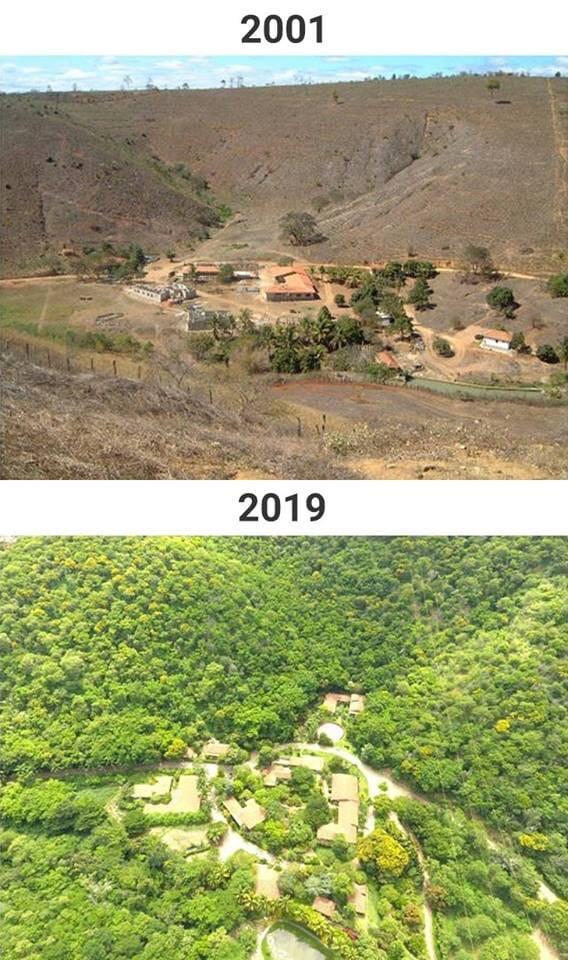Today I Learned About A Couple That Decided To Rebuild Their Deserted Piece Of Land Of 600 Hectares In
Today I learned about a couple that decided to rebuild their deserted piece of land of 600 hectares in Aimorés, Brazil. They planted more than 2 million tree saplings. As a result, the site has 293 plant species, 172 bird species and 33 animal species, some of which were on the verge of extinction. It only took 18 years!

In the early 1990s, Brazilian photo-journalist Sebastião Ribeiro Salgado was stationed in Rwanda to cover the horrific accounts of Rwanda genocide. The on-ground experience left him traumatised. In 1994, he was returning to his home in Minas Gerais, Brazil, with a heavy heart, hoping to find solace in the lap of a lush green forest, where he had grown up.
But, instead, he found dusty, barren land for miles and miles, in place of the forest. In only a few years, his beautiful hometown underwent rampant deforestation, leaving it fallow and devoid of all the wildlife. For him, everything was destroyed. “The land was as sick as I was. Only about 0.5% of the land was covered in trees,’ he shared in an interview with The Guardian. Salgado was shattered.
Saldago’s Wife Wanted to Recreate The Forest
It was at this time that Salgado’s wife Lélia made a near-impossible proposal. She expressed her wish to replant the entire forest. Salgado supported her idea, and together the couple set out on a heroic mission. Brazil Photographer Forest
Salgado bought an abandoned cattle ranch from his parents and started building a network of enthusiastic volunteers and partners who would fund and sustain their mammoth project. In 1998, the couple founded Instituto Terra – the organisation which tirelessly worked to bring a forest back to life.

PNHR Bulcão Farm | by Weverson Rocio – 2012
Salgado sowed the first seed in December 1999. The couple hired around 24 workers in the beginning and was later joined by numerous volunteers over the years. They worked day and night – from uprooting the invasive weeds to planting new seedlings. Soon, their hard work bore fruit as tropical trees native to the region started flourishing in the area. They received a donation of over one lakh saplings which gave rise to a dense forest. The handcrafted forest comprises mostly of local arboreal and shrub varieties. Latest satellite imagery revealed how a soothing green forest cover has enveloped the area which once was a devastating arid eyesore.Since 1998, they have planted more than 2 million saplings of 293 species of trees and rejuvenated 1,502 acres of tropical forest. The biodiversity-rich zone has recently been declared as a Private Natural Heritage Reserve (PNHR).
The Impact of Salgado’s Forest
The afforestation project, which is undoubtedly one of the greatest environmental initiatives in the world, has also helped to control soil erosion and revived the natural springs in the area. Eight water springs which once dried up, flow at around 20 litres per minute at present, relieving the drought-prone region of its woes. Salgado’s forest also happens to solve the much-debated notion about climate change, proving that the trend can be reversed if tried. His forest has resulted in causing more rainfall to the area and cooler weather, bringing a drastic and desirable change in the climate.

Instituto Terra’s Fauna | by Leonardo Merçon – 2012
The most important positive aspect of the forest till now has to be the return of the lost fauna. More than 172 species of birds, 33 species of mammals, 15 species of amphibians and reptiles have been spotted in the forest interiors, something which was beyond imagination two decades ago. Many of the plant and animal species in his forest actually feature on the endangered list.
Efforts For Good
Climate change is a harsh reality. Mankind is bearing the brunt of the relentless destruction they inflicted on the planet. Yet, people like Salgado and Lélia fill us with hope, proving that patience and persistence can be our keys to heal the wounds of nature. If two people can create a 1502-acre forest in just 20 years, then imagine how much can be done if everyone comes together to protect the environment. It must be reminded that for every tree we plant, we are adding 118 kgs of oxygen to the air every year, and reducing the carbon footprint by 22 kgs.
Efforts For Good urges all the readers to actively engage in planting trees and gradually turn this into a fixed habit.
Sources: http://www.scienceinsanity.com/2019/03/brazilian-couple-created-1502-acre.html
https://www.reddit.com/r/interestingasfuck/comments/bg0ebn/a_couple_decided_to_rebuild_their_deserted_piece/
More Posts from Chaos3612 and Others


Appearing like trenches dragged into the earth, sunken lanes, also called hollow-ways or holloways, are centuries-old thoroughfares worn down by the traffic of time. They’re one of the few examples of human-made infrastructure still serving its original purpose, although many who walk through holloways don’t realize they’re retracing ancient steps.
- Allison Meier in Atlas Abscura

Be chaotic, and never know anything

One of my favorite “never thought of that, but makes sense” facts is that the moon looks upside-down if you see it from the other hemisphere.

When my friend from Brazil landed in the US for the first time, she stepped off the plane and saw an upside-down moon, which is more than a little alarming when you’re jetlagged and nervous about moving to a new country.
fuck the zodiac tell me which sin rules your personality
The Universe's Brightest Lights Have Some Dark Origins
Did you know some of the brightest sources of light in the sky come from black holes in the centers of galaxies? It sounds a little contradictory, but it’s true! They may not look bright to our eyes, but satellites have spotted oodles of them across the universe.
One of those satellites is our Fermi Gamma-ray Space Telescope. Fermi has found thousands of these kinds of galaxies in the 10 years it’s been operating, and there are many more out there!

Black holes are regions of space that have so much gravity that nothing - not light, not particles, nada - can escape. Most galaxies have supermassive black holes at their centers - these are black holes that are hundreds of thousands to billions of times the mass of our sun - but active galactic nuclei (also called “AGN” for short, or just “active galaxies”) are surrounded by gas and dust that’s constantly falling into the black hole. As the gas and dust fall, they start to spin and form a disk. Because of the friction and other forces at work, the spinning disk starts to heat up.

The disk’s heat gets emitted as light - but not just wavelengths of it that we can see with our eyes. We see light from AGN across the entire electromagnetic spectrum, from the more familiar radio and optical waves through to the more exotic X-rays and gamma rays, which we need special telescopes to spot.

About one in 10 AGN beam out jets of energetic particles, which are traveling almost as fast as light. Scientists are studying these jets to try to understand how black holes - which pull everything in with their huge amounts of gravity - somehow provide the energy needed to propel the particles in these jets.

Many of the ways we tell one type of AGN from another depend on how they’re oriented from our point of view. With radio galaxies, for example, we see the jets from the side as they’re beaming vast amounts of energy into space. Then there’s blazars, which are a type of AGN that have a jet that is pointed almost directly at Earth, which makes the AGN particularly bright.

Our Fermi Gamma-ray Space Telescope has been searching the sky for gamma ray sources for 10 years. More than half (57%) of the sources it has found have been blazars. Gamma rays are useful because they can tell us a lot about how particles accelerate and how they interact with their environment.

So why do we care about AGN? We know that some AGN formed early in the history of the universe. With their enormous power, they almost certainly affected how the universe changed over time. By discovering how AGN work, we can understand better how the universe came to be the way it is now.

Fermi’s helped us learn a lot about the gamma-ray universe over the last 10 years. Learn more about Fermi and how we’re celebrating its accomplishments all year.
Make sure to follow us on Tumblr for your regular dose of space: http://nasa.tumblr.com.
I love solving mathematical problems. They calm me and cheer me up. They are like meditation to me.
I’m missing them a lot this week. I'm currently writting a paper and is quite urgent, so I don't have time for them. It isn't that I hate writting, I actually quite enjoy it. But it's been a terrible week and I miss my maths.
I think schools need to emphasize more that they aren’t teaching specific facts but rather skill sets
are you gonna remember your algebra formulas ten years from now? Probably not. Are you going to be able to use basic logic to solve problems? Well hopefully with some solid logic practice, such as math, yeah!
did Shakespeare really mean that all of the themes of dark and light in his plays indicated internal struggle and opposing forces? Who knows! Is the ability to critically analyze a piece of writing and see larger trends and symbols useful? Hell yes!
Schools should really be upfront with students that no, this isn’t going to be wholly applicable, but any amount of school will develop your self-discipline and overall versatility- and that’s a good thing
-
 yfan1814 reblogged this · 1 month ago
yfan1814 reblogged this · 1 month ago -
 sirquacklesdefoof liked this · 1 month ago
sirquacklesdefoof liked this · 1 month ago -
 mim8icri reblogged this · 1 month ago
mim8icri reblogged this · 1 month ago -
 darthbloodorange reblogged this · 2 months ago
darthbloodorange reblogged this · 2 months ago -
 sich-el reblogged this · 2 months ago
sich-el reblogged this · 2 months ago -
 karlazul liked this · 3 months ago
karlazul liked this · 3 months ago -
 wordslikewings reblogged this · 8 months ago
wordslikewings reblogged this · 8 months ago -
 loooooooooooooooooooooooooooooob reblogged this · 8 months ago
loooooooooooooooooooooooooooooob reblogged this · 8 months ago -
 dawgywhatnow reblogged this · 9 months ago
dawgywhatnow reblogged this · 9 months ago -
 dawgywhatnow liked this · 9 months ago
dawgywhatnow liked this · 9 months ago -
 metallic-mermaid reblogged this · 9 months ago
metallic-mermaid reblogged this · 9 months ago -
 clmorsefiction liked this · 9 months ago
clmorsefiction liked this · 9 months ago -
 toonlarsson liked this · 9 months ago
toonlarsson liked this · 9 months ago -
 lastoftheptolemies reblogged this · 9 months ago
lastoftheptolemies reblogged this · 9 months ago -
 sunray-sunray reblogged this · 9 months ago
sunray-sunray reblogged this · 9 months ago -
 soniciselectricc liked this · 10 months ago
soniciselectricc liked this · 10 months ago -
 brainboomscience reblogged this · 11 months ago
brainboomscience reblogged this · 11 months ago -
 makerooni liked this · 1 year ago
makerooni liked this · 1 year ago -
 hitchhikerwithoutguide reblogged this · 1 year ago
hitchhikerwithoutguide reblogged this · 1 year ago -
 flurgerbla reblogged this · 1 year ago
flurgerbla reblogged this · 1 year ago -
 flurgerbla liked this · 1 year ago
flurgerbla liked this · 1 year ago -
 uncovertheuniverse reblogged this · 1 year ago
uncovertheuniverse reblogged this · 1 year ago -
 pretzel-face reblogged this · 1 year ago
pretzel-face reblogged this · 1 year ago -
 reaching-my-summit reblogged this · 1 year ago
reaching-my-summit reblogged this · 1 year ago -
 reaching-my-summit liked this · 1 year ago
reaching-my-summit liked this · 1 year ago -
 theswampratandtheriverrat reblogged this · 1 year ago
theswampratandtheriverrat reblogged this · 1 year ago -
 turqis reblogged this · 1 year ago
turqis reblogged this · 1 year ago -
 the-sassy-alchemist reblogged this · 1 year ago
the-sassy-alchemist reblogged this · 1 year ago -
 push-pause reblogged this · 1 year ago
push-pause reblogged this · 1 year ago -
 joonatical reblogged this · 1 year ago
joonatical reblogged this · 1 year ago -
 slithy-tove liked this · 1 year ago
slithy-tove liked this · 1 year ago -
 thefriendlyneighborhoodqueer liked this · 1 year ago
thefriendlyneighborhoodqueer liked this · 1 year ago -
 crabbyapplesauce reblogged this · 1 year ago
crabbyapplesauce reblogged this · 1 year ago -
 crestfallercanyon liked this · 1 year ago
crestfallercanyon liked this · 1 year ago -
 misteline reblogged this · 1 year ago
misteline reblogged this · 1 year ago -
 misteline liked this · 1 year ago
misteline liked this · 1 year ago -
 sunrae82581 reblogged this · 1 year ago
sunrae82581 reblogged this · 1 year ago -
 slightlysaltedcheddar liked this · 1 year ago
slightlysaltedcheddar liked this · 1 year ago -
 foxglovers reblogged this · 1 year ago
foxglovers reblogged this · 1 year ago -
 klaraisintoscience reblogged this · 1 year ago
klaraisintoscience reblogged this · 1 year ago -
 foxglovers liked this · 1 year ago
foxglovers liked this · 1 year ago -
 missy-green-eyes reblogged this · 1 year ago
missy-green-eyes reblogged this · 1 year ago -
 imaginingstorms liked this · 1 year ago
imaginingstorms liked this · 1 year ago -
 foalystechcrew liked this · 1 year ago
foalystechcrew liked this · 1 year ago

Small and angry.PhD student. Mathematics. Slow person. Side blog, follow with @talrg.
213 posts







